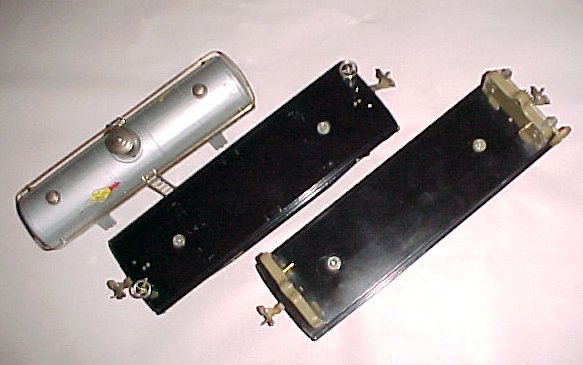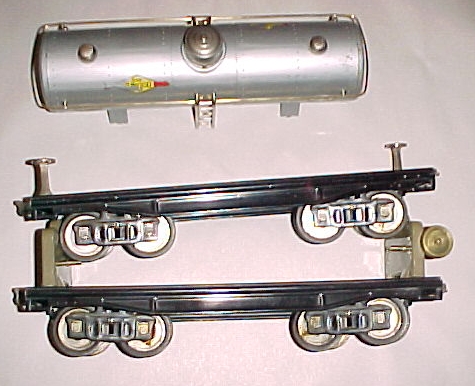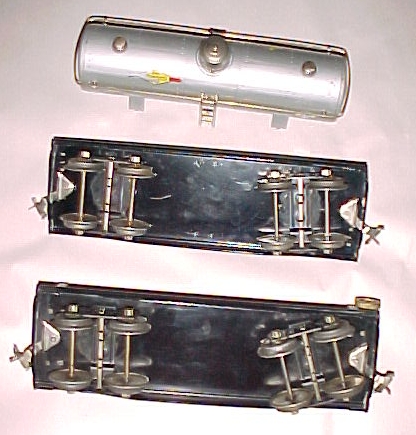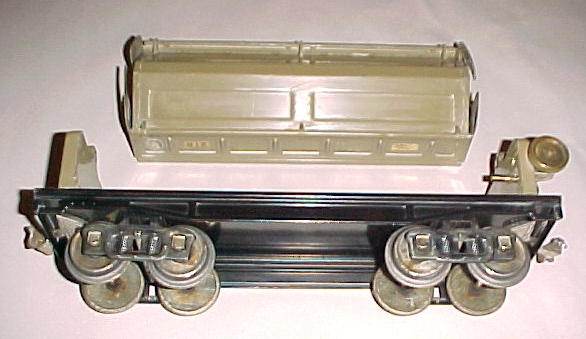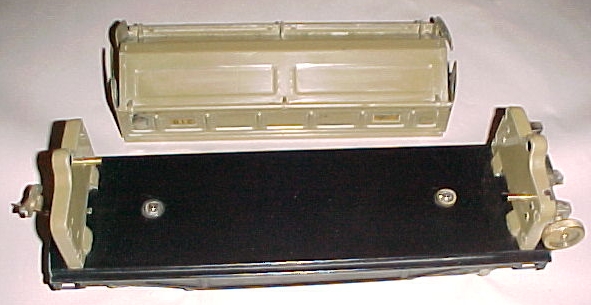I am a student of 200-series freight cars. When I began collecting in 1973, an HO modeler told me he had seen some large old trains in an attic in Danville, Illinois. The attic turned out to be the third-floor ballroom of the 16,000 square foot Hegeler mansion. Luckily I was in my 20's, or I would have had a heart attack when I walked into the room.
Gathering dust on the ballroom floor were many antiques including a four-car Green state set with a State Green 408E, and a 1933 outfit 423E -- a 400E with seven freight cars. The two Hegeler sons, Edward and Julius, were born in 1926 and 1928 respectively and each got the top-of-the-line outfit from Marshall Field's in Chicago.
Actually the trains must have been for Dad as there was a custom made outside-third-rail layout from Walther's. A double oval about 15 feet by 30 feet with no center rail and two long switches for a passing track. The layout sat on the floor and was hand-made with brass rails and roofing shingles used as ballast. Walther's made these custom layouts to order as described in a 1928 "Model Engineer" article I found in the ballroom. The loco pickups had been professionally-modified with sprung brass rods for the outside third-rail electrical pick up. I subsequently put the loco pickups back to stock Lionel configuration. The Walther's layout is still in the ballroom.
Note: There was no other Lionel Standard Gauge in the ballroom except these two sets. No accessories, extra track, cars, etc. Just these two cataloged sets. I emphasize this since books say that 400E's were Black thru 1933. The 423E set was last cataloged in 1933, yet this one has a Dark Gunmetal loco and tender (with brass, Red plates). The loco has copper boiler bands -- not the painted ones generally found with the last brass-trim 400E's. Click 423E for photos.
The family bought nothing else, so the freight outfit had to come in 1933. There were also some VoltAmp pieces, a lot of VoltAmp wooden base 2-gauge track (now in the Sefton collection as a gift from me), and a Marklin 3-gauge freight station (really large) from the grandfather's era (circa 1908).
Wealthy families often don't discard things. They just put them in the unused ballroom. The Hegeler house is L-shaped on the North (left) side and is larger than it looks in this photo. The ballroom is on the third floor and nearly the size of a basketball court (where you see the top-floor dormers). Counting the carriage house, there is 16,000 usable square feet -- plus a not-counted attic above the ballroom (note the topmost window on the right side). This is a big joint.
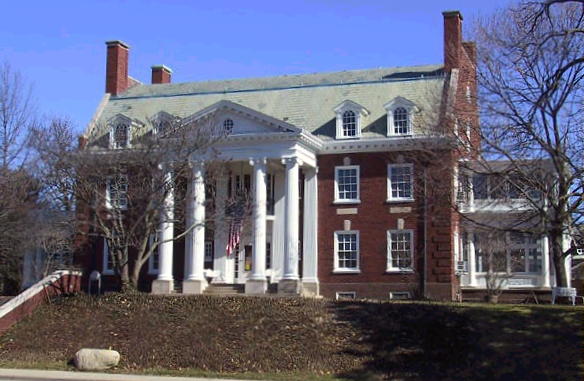
The freight set consisted of a Dark Gunmetal 400E with Red solid lead wheels, copper boiler bands, and a brass/Red nameplate on the tender. Chugger, but no whistle. The freight cars were 211-212-213-214-215-216-217 (the rich kid's set). All were series M3 with one-piece brass brake wheels, copper journals, and generally type D2 trucks (held on by D-clips not cotter pins).
This set goes against the theory that 400E's were Black thru 1933 since Outfit 423E was last cataloged that year. This family just had the two sets -- no accessories or extra cars. Further, this Gunmetal 400E has a 3-position reverse unit controlled by a thin tab coming out of the boiler top. Some think 1933 locos still used the old 2-position pendulum reverse unit. Not so.
Caryl Pettijohn's ("CJ") recent series of articles in the TCA quarterly are great, and I have passed on to him some unnoted cars. Lionel was using up parts in the depression. One car I had was a 214R with screw-held 1926 trucks though the 214R did not appear until 1929 (CP has seen a similar). Exceptions to the articles include common-colors 212 and 214 with screw-held trucks, and common-colors 212 and 214 with the smaller Type 1 brake wheels (different cars). These are variants -- when Lionel was in receivership they undoubtedly used every spare part sitting around the factory.
I do not have the room or money to have 100 EX+ variations of 200-series cars, so I have tried to find combinations that would cover all of the color types with interesting engines. The way to do this is to ignore the common BT NJ cars with C4 trucks (cotter pins, no dimples, no slots). Lionel must have busted or worn out this die as later copper journal trucks and nickel-trimmed cars reappeared with the dimpled trucks. Dimples had not been necessary since the electric pickup pre-1926 trucks that had no cross brace.
The CP articles have messed me up, but Caryl is much more of a 200-series student than me. I had long thought that the early 200-series cars were issued in 1926 and 1927, so a Mojave 408E would be the cool loco for the early-colored cars. His argument is that no 218 or 219 cars appear with early Type 1 couplers (1926) or C1 trucks (crossbar with dimples and slots), so the early-color cars 211 thru 217 must be 1926 only, and the 218-219 cars came later (1927).
Hmmm. My "early" 218 (peacock windows) and "early" 219 (two knobs) follow CP's specs. They have type 2 couplers and type C3 trucks (slots, but no dimples). Photos are below. What's up? Did Lionel actually catalog these two cars in 1926, but never produce them? Did the rest of the cars (211-217) switch to common colors in 1927?
Probably Lionel produced cars in large batches. I find it hard to believe they would catalog a 218-219 in 1926 and not manufacture them. Also there are a lot of the Mojave/Maroon 213 cattle cars around -- more than probable 1926 production (Terra Cotta box cars and Orange caboose are much more scarce). Check the couplers on your early color 213's -- five-piece with brass retainer of four-piece without? Could the coupler and truck switch have taken place in late 1926 before the 218-219 cars were made? Were the 218-219 cars issued in late 1926?
The CP articles have messed me up in another vein. Did copper journals appear in 1930 or 1931? CP's main argument for 1930 is that 220 Floodlight cars (1931) always had one-piece M3 brake wheels, but many copper journal cars appear with two-piece M2 brake wheels, hence earlier (1930) production. I feel more strongly in arguing that copper journals were not used until 1931 than I do in the early 1926-27 discrepancy above. There are many fewer common-color, copper journal cars around compared to nickel journal ones. Yet we are to believe that nickel-journal, common-color cars were from only 1927-29 and copper-journal, common-color ones from 1930-1934? Three years and many nickel-journal cars versus five years and many fewer copper-journal cars? The Great Depression was rough, but probably not to this degree. Perhaps Lionel switched to copper journals in 1931 and the to one-piece brake wheels late in 1931 production when the batch was made for the new Floodlight car?
